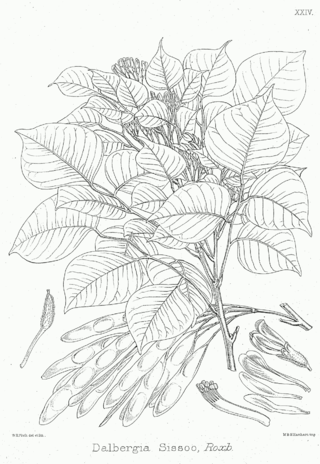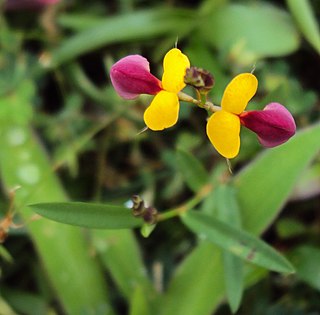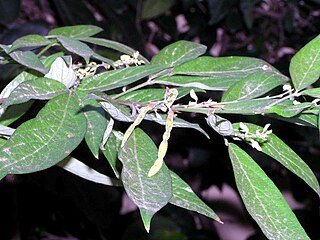
Dalbergia is a large genus of small to medium-size trees, shrubs and lianas in the pea family, Fabaceae, subfamily Faboideae. It was recently assigned to the informal monophyletic Dalbergia clade : the Dalbergieae. The genus has a wide distribution, native to the tropical regions of Central and South America, Africa, Madagascar and Southern Asia.

Afzelia is a genus of plants in family Fabaceae. The thirteen species all are trees, native to tropical Africa or Asia.

Cocculus is a genus of four species of woody vines and shrubs, native to tropical and subtropical regions of Africa and Asia.

Endoclita is a genus of moths of the family Hepialidae. There are 60 described species found in eastern and southeast Asia and the Indian subcontinent.

Najas, the water-nymphs or naiads, is a genus of aquatic plants. It is cosmopolitan in distribution, first described for modern science by Linnaeus in 1753. Until 1997, it was rarely placed in the Hydrocharitaceae, and was often taken as constituting the family Najadaceae.

Phoebe is a genus of evergreen trees and shrubs belonging to the Laurel family, Lauraceae. There are 75 accepted species in the genus, distributed in tropical and subtropical Asia and New Guinea. 35 species occur in China, of which 27 are endemic. The first description of the genus was of the type species P. lanceolata made in 1836 by Christian Gottfried Daniel Nees von Esenbeck in Systema Laurinarum, p. 98.

Alysicarpus is a genus of flowering plants in the legume family, Fabaceae. It is distributed in tropical and subtropical regions of Africa, Asia, and Australia. Species are known generally as moneyworts. Unusually for legumes, the leaves are simple.

Ohwia caudata, formerly placed in the genus Desmodium, is a deciduous nitrogen fixing plant in the family Fabaceae. It is found in India, China, Taiwan and other parts of Asia. The shrub grows to a height of about 1.5 m tall. It is related to Arthroclianthus, Nephrodesmus and Hanslia. The leaves and roots of the plant are used as an insecticide.

Piliostigma is a genus of flowering plants in the legume family, Fabaceae. It includes five species of small deciduous trees native to sub-Saharan Africa, the Indian subcontinent, Indochina, Java, the Philippines, and northern Australia. It belongs to the subfamily Cercidoideae and the tribe Bauhinieae. It is dioecious, with male and female flowers on separate plants.

Christia is a genus of flowering plants in the family Fabaceae. It belongs to the subfamily Faboideae.
Dysolobium is a genus of flowering plants in the legume family, Fabaceae. It belongs to the subfamily Faboideae. It includes five species native to tropical Asia, ranging from the Himalayas through Indochina to southern China, Taiwan, the Philippines, Peninsular Malaysia, and Java.
Endosamara is a monotypic genus of flowering plants in the legume family Fabaceae, tribe Wisterieae. Its only species is Endosamara racemosa, a liana found from South India through Indo-China to the Philippines.
Leptodesmia is a genus of flowering plants in the legume family, Fabaceae. It belongs to the subfamily Faboideae. It includes four species ranging from Madagascar and the Comoros to the Indian subcontinent, Indochina, China, Japan, Malesia, New Guinea, and Queensland.
Mastersia is an Asian genus of flowering plants in the legume family, Fabaceae. It belongs to the subfamily Faboideae. It contains two species of lianas or twining herbs. Typical habitat is seasonally-dry tropical forest, often in open places, including both wet and dry sites.
Neocollettia is a genus of flowering plants in the legume family, Fabaceae. It includes a single species, Neocollettia wallichii, a perennial native to Myanmar and Java. It belongs to the subfamily Faboideae.
Nogra is a genus of flowering plants in the legume family, Fabaceae. It includes four species of herbs native to Asia, ranging from India to Myanmar, Thailand, Laos, and southern China. They typically grow in seasonally-dry tropical forest, often in open grassy areas. The genus belongs to subfamily Faboideae.

Phyllodium is a genus of flowering plants in the family Fabaceae, in the subfamily Faboideae, tribe Desmodieae and subtribe Desmodiinae. Species are found in tropical and subtropical Asia through to northern Australia.

The tribe Desmodieae is one of the subdivisions of the plant family Fabaceae. It is composed of two subtribes, Desmodiinae and Lespedezinae. Recent phylogenetics has this tribe nested within tribe Phaseoleae.
Padbruggea is a genus of flowering plants in the family Fabaceae. Its native range stretches from southern China to western Malesia.

Sohmaea is a genus of flowering plants belonging to the family Fabaceae.












